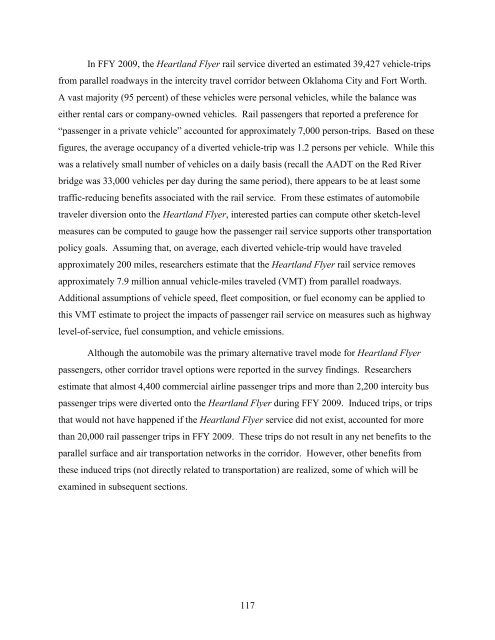Measuring the Benefits of Intercity Passenger Rail: A Study
Measuring the Benefits of Intercity Passenger Rail: A Study
Measuring the Benefits of Intercity Passenger Rail: A Study
Create successful ePaper yourself
Turn your PDF publications into a flip-book with our unique Google optimized e-Paper software.
In FFY 2009, <strong>the</strong> Heartland Flyer rail service diverted an estimated 39,427 vehicle-trips<br />
from parallel roadways in <strong>the</strong> intercity travel corridor between Oklahoma City and Fort Worth.<br />
A vast majority (95 percent) <strong>of</strong> <strong>the</strong>se vehicles were personal vehicles, while <strong>the</strong> balance was<br />
ei<strong>the</strong>r rental cars or company-owned vehicles. <strong>Rail</strong> passengers that reported a preference for<br />
“passenger in a private vehicle” accounted for approximately 7,000 person-trips. Based on <strong>the</strong>se<br />
figures, <strong>the</strong> average occupancy <strong>of</strong> a diverted vehicle-trip was 1.2 persons per vehicle. While this<br />
was a relatively small number <strong>of</strong> vehicles on a daily basis (recall <strong>the</strong> AADT on <strong>the</strong> Red River<br />
bridge was 33,000 vehicles per day during <strong>the</strong> same period), <strong>the</strong>re appears to be at least some<br />
traffic-reducing benefits associated with <strong>the</strong> rail service. From <strong>the</strong>se estimates <strong>of</strong> automobile<br />
traveler diversion onto <strong>the</strong> Heartland Flyer, interested parties can compute o<strong>the</strong>r sketch-level<br />
measures can be computed to gauge how <strong>the</strong> passenger rail service supports o<strong>the</strong>r transportation<br />
policy goals. Assuming that, on average, each diverted vehicle-trip would have traveled<br />
approximately 200 miles, researchers estimate that <strong>the</strong> Heartland Flyer rail service removes<br />
approximately 7.9 million annual vehicle-miles traveled (VMT) from parallel roadways.<br />
Additional assumptions <strong>of</strong> vehicle speed, fleet composition, or fuel economy can be applied to<br />
this VMT estimate to project <strong>the</strong> impacts <strong>of</strong> passenger rail service on measures such as highway<br />
level-<strong>of</strong>-service, fuel consumption, and vehicle emissions.<br />
Although <strong>the</strong> automobile was <strong>the</strong> primary alternative travel mode for Heartland Flyer<br />
passengers, o<strong>the</strong>r corridor travel options were reported in <strong>the</strong> survey findings. Researchers<br />
estimate that almost 4,400 commercial airline passenger trips and more than 2,200 intercity bus<br />
passenger trips were diverted onto <strong>the</strong> Heartland Flyer during FFY 2009. Induced trips, or trips<br />
that would not have happened if <strong>the</strong> Heartland Flyer service did not exist, accounted for more<br />
than 20,000 rail passenger trips in FFY 2009. These trips do not result in any net benefits to <strong>the</strong><br />
parallel surface and air transportation networks in <strong>the</strong> corridor. However, o<strong>the</strong>r benefits from<br />
<strong>the</strong>se induced trips (not directly related to transportation) are realized, some <strong>of</strong> which will be<br />
examined in subsequent sections.<br />
117
















